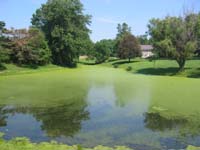Why Aerate My Pond??


 Many ponds and lakes contain moderate to high amounts of nutrients (namely, phosphorus and nitrogen). Elevated nutrient levels can adversely impact fish, other aquatic organisms and water quality during the summer months. Too many nutrients in ponds and lakes can result in accelerated rates of eutrophication.
Many ponds and lakes contain moderate to high amounts of nutrients (namely, phosphorus and nitrogen). Elevated nutrient levels can adversely impact fish, other aquatic organisms and water quality during the summer months. Too many nutrients in ponds and lakes can result in accelerated rates of eutrophication.
Eutrophication is a process whereby pond and lakes excessive nutrients that stimulate excessive plant growth (algae and aquatic plants). Dissolved oxygen concentrations can severely decline when large amounts of algae (algal bloom) and aquatic plants begin to decompose. In turn, very low dissolved oxygen concentrations can cause other aquatic organisms to die. Nutrients can come from many sources, such as fertilizers applied to agricultural fields, golf courses, suburban lawns, soil erosion, streambank erosion and sewage treatment plant discharges. The symptoms of eutrophication are:
- Low Dissolved Oxygen Concentrations
- Eutrophic Pond Covered in Duckweed & Watermeal
- Poor Water Clarity (Transparency)
- Algal Blooms (Excessive Amounts of Algae)
- Excessive Quantities of Aquatic Plants (Weeds)
- High Dissolved Metal Concentrations (Iron & Manganese)
- Stress to Fishery and Other Forms of Aquatic Life (Fish Kills)
- Shallowness Due to the Accumulation of Sediments
- Nutrient Releases via Anoxic In-Lake Sediments
- Buildup and Release of Noxious Odors
Surface Aeration - are systems that come in the form of Fountains or Jets and are primarily used to produce surface level oxygen in the water. They splash the surface and help control top level algae and weeds, they do not aerate down to the bottom. This type of aeration looks attractive but as research indicates, is one of the most ineffective ways to keep your water healthy. Oxygen never gets to the bottom of the water where it is needed to organically break down the sludge that constantly enters the water and sinks down.
Diffused Aeration – are systems where air is pumped into the water and through air diffusers that lie at the bottom of the pond, lake, or dugout. This achieves total pond aeration from the bottom to the top regardless of the depth of the water. These systems are both more effective and economical, for it requires far less energy to push air in a diffused aeration system than it does pushing water through fountains or jets.


